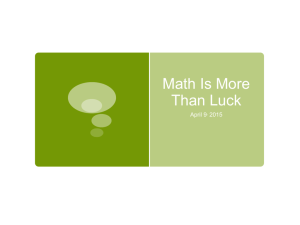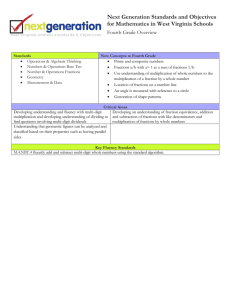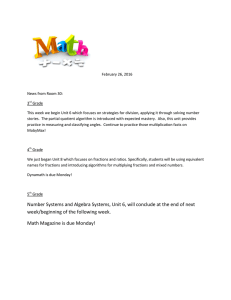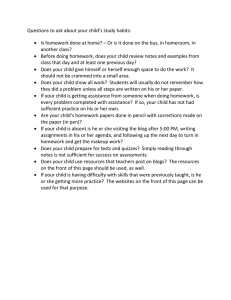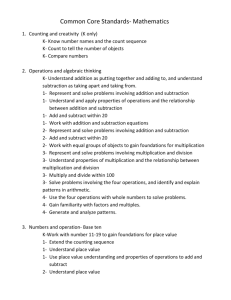Saxon Math Draft Common Core Standards The Difference That Gets Results
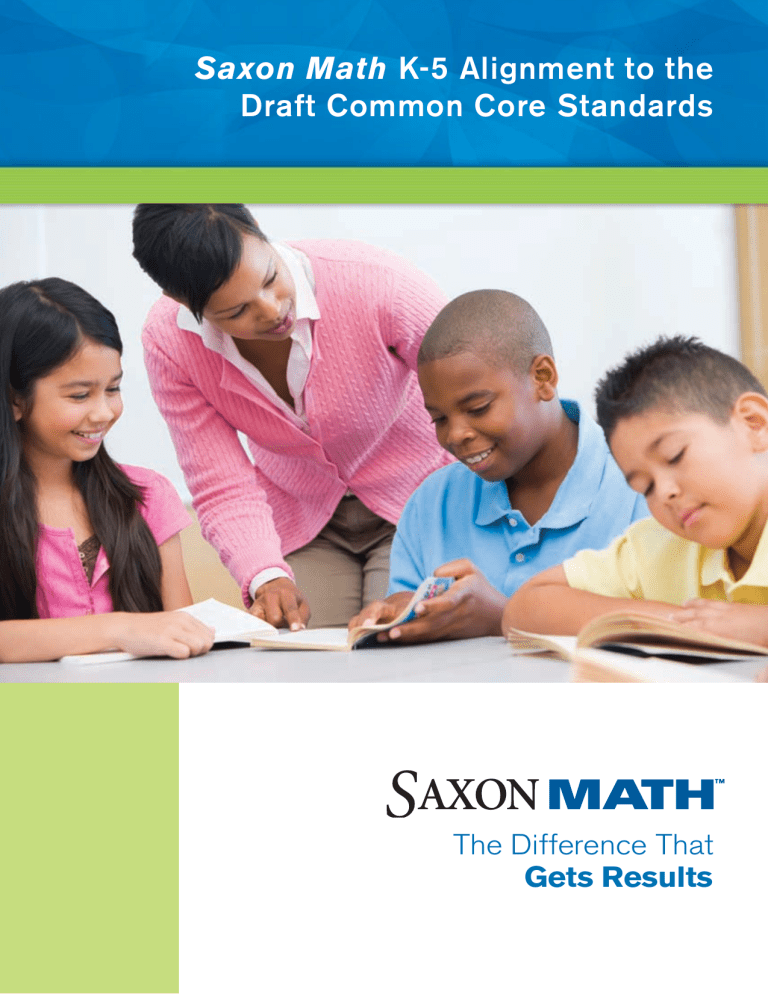
Saxon Math K-5 Alignment to the
Draft Common Core Standards
The Difference That
Gets Results
The Common Core State Standards for
Mathematics is an initiative towards more focused grade level standards and a focused, coherent curriculum. The draft Common Core State
Standards for Mathematics point to conceptual understanding of the key ideas, and continually returning to organizing principles such as place value or the laws of arithmetic to structure those ideas.
These draft standards define the knowledge and skills students should have within their K-12 education careers so that they will graduate high school and be able to succeed in credit-bearing academic college courses and in workforce training programs.
The following is a guide that explains and identifies the alignment of key Kindergarten to 5th grade lessons within
Saxon Math
to the March 9, 2010 public draft of the Common Core Standards. The grade-level overviews and standards from the public draft are cited, along with their correlation to the critical lessons in
Saxon Math
.
The
Saxon Math
pedagogy allows for reinforcement, practice, and assessment of concepts throughout the entire year with its integrated and distributed structure. Content is articulated over time as a sequence of topics and performances that are logical and reflect, where appropriate, the hierarchical nature of the disciplinary content. This coherent structure ensures a deep mastery and thorough understanding of these focused concepts.
1
Saxon Math— The Difference That Gets Results
2
Saxon Math K
Kindergarten students using Saxon Math employ a variety of objects and tools to represent, compare, join, and separate sets, including teddy bear counters, coins, linking cubes, dot cubes, number cards, playing cards, a 100 number chart, and number lines.
Card games, bingo, dominoes, “connect-the-dots” and a classroom store are examples of enjoyable and engaging activities that help students master the common core standards related to numbers. Combining and separating stories are acted out through the use of manipulatives and are represented by student drawings. These stories are well known by students as
“some, some more” and “some, some went away” problems.
The geometry standards are visited daily and are supported through relational vocabulary terms with phrases such as behind, beside, inside, outside, “on top of”, and “in back of”. Students interact with, identify, describe, and compare squares, circles, rectangles, hexagons, trapezoids, parallelograms, ellipses, rhombuses, cubes, cylinders, spheres, and cones by engaging with pattern blocks, shape pieces, tangrams, geometric solid models, geoboards, and real-world objects. Through the use of manipulatives students construct both simple and complex shapes by the acts of flipping, sliding, and turning. All of these standards are developed in an incremental and distributed approach through the embedded “best practices” of the modeled lessons. This unique pedagogy puts all of the kindergarten common core standards within the reach of every student, regardless of their educational experiences before entering their kindergarten class.
Kindergarten
In Kindergarten, instructional time should focus on two critical areas: (1) representing, comparing and ordering whole numbers and joining and separating sets; (2) describing shapes and space. More learning time in Kindergarten should be devoted to number than to other topics.
(1) Students use numbers, including written numerals, to represent quantities and to solve quantitative problems, such as counting objects in a set; creating a set with a given number of objects; comparing and ordering sets or numerals; and modeling simple joining and separating situations with objects. They choose, combine, and apply effective strategies for answering quantitative questions, including quickly recognizing the cardinalities of small sets of objects, counting and producing sets of given sizes, counting the number of objects in combined sets, or counting the number of objects that remain in a set after some are taken away.
(2) Students describe their physical world using geometric ideas (e.g., shape, orientation, spatial relations) and vocabulary.
They identify, name, and describe basic shapes, such as squares, triangles, circles, rectangles, (regular) hexagons, and
(isosceles) trapezoids, presented in a variety of ways (e.g., with different sizes or orientations), as well as three-dimensional shapes such as spheres, cubes, and cylinders. They use basic shapes and spatial reasoning to model objects in their environment and to construct more complex shapes.
http://www.corestandards.org/Files/K12MathStandards.pdf
©2009 National Governors Association and Council of Chief State School Officers
Grade K Critical Meetings and Lessons: Meetings: 3, 4A, 6-25, 27, 44, 73, 89, 119, 121, 127, 128 and Lessons: 5, 6, 7, 8, 9, 11, 13, 15, 16, 17, 18, 19, 21,
22, 24, 27, 29, 31, 34, 35, 36, 38, 42, 44, 49, 50-2, 53, 58, 61, 64, 65, 67, 68, 69, 71, 72, 73, 74, 79, 80-1, 80-2, 83, 84, 87, 89, 90-1, 93, 98, 99, 102, 105,
106, 108, 109, 113, 114, 117, 118, 119, 121, 123, 127, 128, 131,132, 133
3
Saxon Math— The Difference That Gets Results
4
Saxon Math 1
In Saxon Math 1 , special attention is given to the topics of addition and subtraction. Written practice, Wrap Ups, fact cards, raps, and memory games use many learning modalities to help reinforce the concepts of addition and subtraction.
These concepts are often introduced by means of linking cubes. Various strategies, like “making ten” and fact families, provide a conceptual foundation for these operations. Students identify the commutative property of addition by matching related fact cards. They also discover the associative property of addition by dividing a group of ten pennies into three groups before finding their sum in various orders.
Every day during the Math Meeting, a linking cube is added to a continued collection. These linking cubes are grouped into towers of ten to help students understand the place value of two-digit numbers. Work with dimes and pennies adds to this understanding as well.
The routines in Saxon Math aid students in linear measurement. Before students draw and measure the line for their name each day on the Guided Class Practice worksheet, they will have sufficient practice holding and using a ruler to make line segments.
The importance of units is discussed as both small and large paper clips are used to measure various objects. First-grade students using Saxon Math identify lines of symmetry and create their own symmetric shapes. Geoboards and geodot drawings emphasize congruent shapes, as do the opposite sides of a rectangular prism that is decomposed and examined during a lesson in the second half of the year. Students compare and contrast the different geometric solids by the determining sorting rule that separates them. A variety of sliced vegetables convey part-whole relationships in a fun-filled activity.
Grade 1
In Grade 1, instructional time should focus on four critical areas: (1) developing understanding of addition, subtraction, and strategies for additions and subtractions within 20; (2) developing understanding of whole number relationships, including grouping in tens and ones, (3) developing understanding of linear measurement and measuring lengths, and (4) composing and decomposing geometric shapes.
(1) Students develop strategies for adding and subtracting whole numbers based on their prior work with small numbers.
They use a variety of models, including discrete objects and length-based models (e.g., cubes connected to form lengths), to model —put together/take apart, —add to, —take from, and —compare situations to develop meaning for the operations of addition and subtraction, and to develop strategies to solve arithmetic problems with these operations. Students understand connections between counting and addition and subtraction (i.e., adding two is the same as counting on two).
They use properties of addition (commutativity and associativity) to add whole numbers and to create and use increasingly sophisticated strategies based on these properties (e.g., —making tens) to solve addition and subtraction problems within
20. By comparing a variety of solution strategies, children build their understanding of the inverse relationship between addition and subtraction.
(2) Students compare and order whole numbers (at least to 100), to develop understanding of and solve problems involving their relative sizes. They think of whole numbers between 10 and 100 in terms of tens and ones (especially recognizing the numbers 11 to 19 as composed of a ten and some ones). They understand the sequential order of the counting numbers and their relative magnitudes through activities such as representing numbers.
(3) Students develop an understanding of the meaning and processes of measurement, including underlying concepts such as partitioning (the mental activity of decomposing the length of an object into equal-sized units) and transitivity (e.g., in terms of length, if object A is longer than object B and object B is longer than object C, then object A is longer than object C). They understand linear measure as an iteration of units, and use rulers and other measurement tools with that understanding.
(4) Students compose and decompose plane and solid figures (e.g., put two congruent isosceles triangles together to make a rhombus), building understanding of part-whole relationships as well as the properties of the original and composite shapes. As they combine solid and plane figures, they recognize them from different perspectives and orientations, describe their geometric attributes, and determine how they are alike and different, to develop the background for measurement and for initial understandings of properties such as congruence and symmetry.
http://www.corestandards.org/Files/K12MathStandards.pdf
©2009 National Governors Association and Council of Chief State School Officers
Grade 1 Critical Lessons: 2, 3, 4, 5, 6, 7, 8, 9, 10-1, 12, 13, 15-1, 19, 21, 23, 24, 25-1, 27, 28, 30-1, 31, 33, 35-2, 36, 37, 38, 40-1, 40-2, 41, 44, 45-1, 48, 49,
55-1, 55-2, 56, 57, 58, 60-1, 61, 62, 65-1, 66, 67, 68, 70-1, 70-2, 73, 74, 75-1, 75-2, 76, 77, 78, 79, 80-1, 80-2, 81, 82, 84, 85-1, 86, 87, 88, 89, 90-1, 90-2, 91,
94, 95-1, 95-2, 101, 102, 104, 105-1, 106, 107, 111, 112, 114, 115-1, 118, 120-1, 120-2, 121, 123, 124, 125-1, 125-2, 127, 129, 131, 132, 134, 135
5
Saxon Math— The Difference That Gets Results
6
Saxon Math 2
Saxon Math appreciates the importance of mental math and computational fluency. For this reason, the second grade manipulatives-based kit puts special emphasis on addition and subtraction within 20. In addition to the fact practice experienced in the classroom, additional daily, written fact homework is to be completed by students with at-home, adult support.
Standard addition and subtraction algorithms are deeply introduced to students by developing the processes in the context of coins, for instance, trading 10 pennies for a dime when necessary. Special emphasis is also given to “making 10” when many addends are involved. Motion within the 100-number chart provides visualization for the operations that are performed.
Mental math abilities are fostered through the “Number of the Day”. Each student develops their own unique number sentence to obtain this particular value. Daily, cumulative practice and math conversations allow students to progress to the most difficult three-digit algorithms with accuracy, efficiency, and understanding. Skip counting (by twos, threes, fours, fives, tens, 25s, and 100s) and base-ten blocks help students develop number sense within the base-ten system.
A daily part of the Math Meeting involves interpreting base-ten models and writing numbers in expanded form. During second grade, students more deeply analyze the properties of shapes—identifying parallel and perpendicular lines, right angles, faces, vertices, and sides. A typical hands-on activity has students dividing a square into congruent triangles that can form a parallelogram or congruent rectangles that can be joined as a short, long rectangle. In this course students become familiar with the proper terms for transformations and use pattern blocks to compare the areas of drawn shapes.
The Problem of the Day often reinforces the second grade common core geometry standards. “How many cubes can be formed using 12 squares?” is an example.
Grade 2
In Grade 2, instructional time should focus on three critical areas: (1) developing understanding of base-ten notation; (2) developing fluency with additions and subtractions within 20 and fluency with multi-digit addition and subtraction; and (3) describing and analyzing shapes.
(1) Students develop an understanding of the base-ten system (at least to 1000). Their understanding of the base-ten system includes ideas of counting in units (twos, fives, and tens) and multiples of hundreds, tens, and ones, as well as number relationships, including comparing and ordering. They understand multi-digit numbers (up to 1000) written in base-ten notation, recognizing that the digits in each place represent thousands, hundreds, tens, or ones (e.g., 853 is 8 hundreds +
5 tens + 3 ones).
(2) Students use their understanding of addition to develop fluency with additions and subtractions within 20. They solve arithmetic problems by applying their understanding of models for addition and subtraction (such as combining or separating sets or using number lines that begin with zero), relationships and properties of numbers, and properties of addition. They develop, discuss, and use efficient, accurate, and generalizable methods to compute sums and differences of two-digit whole numbers. They select and accurately apply methods that are appropriate for the context and the numbers involved to mentally calculate sums and differences. They develop fluency with efficient procedures, including standard algorithms, for adding and subtracting whole numbers; understand and explain why the procedures work based on their understanding of base-ten notation and properties of operations; and use them to solve problems.
(3) Students describe and analyze shapes by examining their sides and angles. Students investigate, describe, and reason about decomposing and combining shapes to make other shapes. Through building, drawing, and analyzing two- and three-dimensional shapes, students develop a foundation for understanding attributes of two- and three-dimensional space such as area and volume, and properties such as congruence and symmetry that they will learn about in later grades.
http://www.corestandards.org/Files/K12MathStandards.pdf
©2009 National Governors Association and Council of Chief State School Officers
Grade 2 Critical Lessons: 5, 8, 10-1, 11, 12, 15-1, 17, 18, 19, 20-1, 21, 22, 25-1, 25-2, 28, 29, 30-1, 30-2, 31, 32, 33, 34, 35-1, 36, 38, 39, 40-1, 40-2, 41,
43, 44, 45-1, 46, 47, 48, 50-1, 51, 53, 54, 55-1, 55-2, 57, 58, 60-1, 60-2, 61, 62, 63, 64, 65-1, 68, 70-1, 71, 72, 74, 75-1, 76, 77, 78, 79, 80-1, 81, 82, 84, 85-1,
85-2, 87, 88, 89, 90-1, 91, 93, 95-1, 95-2, 98, 99, 100-1, 101, 102, 104, 105-1, 105-2, 107, 109, 110-1, 113, 114, 119, 123, 125-1, 130-1, 135
7
Saxon Math— The Difference That Gets Results
8
Saxon Math 3
Saxon offers two programs for third grade to accommodate the various needs of classrooms and schools at this transitional grade level. Saxon Math 3 is a consumable kit program and Intermediate 3 is a more traditional hardbound text program.
Both programs contain critical lessons that are aligned with the Grade 3 Draft Common Core standards.
Saxon Math 3 , with its integrated approach, allows students to understand the inverse relationship between multiplication and division. Triangular fact cards (based on fact families), function tables, and the checking of quotients through multiplication all help support this understanding. Multiplication is enhanced through extended practice, skip counting, and strategies tied to objects: clocks, calendars, tally marks, squares, and coins. Rectangular arrays of identical rows, stories of equal groups, rectangular area, equal and repeated jumps on a number line, and number sentences are used to represent and supply meaning to multiplication scenarios.
Equal group and sharing stories help bring meaning to division. Division activities incorporate situations to which students can relate; for instance, the sharing of food and school supplies and the partitioning of students into equal teams. Number sense related to unit fractions is developed using a number of partitioned items: paper strips, circles, egg cartons, and line segments. Folding squares in multiple ways helps students understand multiple ways of representing fourths. Pattern blocks allow a large hexagon to represent a unit of value. Students then assign and use a triangle to represent a sixth, a parallelogram to represent a third, and a trapezoid to represent a half. These shapes and numerous other representations allow students to confidently order fractions with common numerators or denominators.
Students enthusiastically identify and draw shapes as they play the polygon board game. Additionally, through the use of toothpicks, students develop the ability to classify triangles by the lengths of their sides. Parallel and perpendicular lines and acute, right, and obtuse angles are also used by students to describe and classify additional polygons.
Saxon Math Intermediate 3
The Saxon Math Intermediate 3 curriculum incorporates the same incremental and distributed approach as the
Saxon Math 3 program. Students develop an understanding of multiplication at this grade level through multiple representations, including repeated addition. Multiplication patterns in the form of function tables, multiplication tables, and rectangular arrays become student tools for developing and referencing facts.
Fluency in multiplication is attained through skip counting and written fact practice during the Power Up and through equal group story problems. These recurring problems involve finding totals; for instance, the number of days in a given number of weeks, the number of sides for a given number of polygons, the number of faces for a given number of cubes, the number of feet in a given number of yards, and the value of a given number of like coins. Multiplication facts are learned in strategic groups, distributed over the course. The inverse relationship between multiplication and division is reinforced as the multiplication table is used as a mathematical reference for solving division problems.
Arrays and equal group stories are student tools used for both multiplication and division. Equations, division stories, divided arrays, and pictures of equal groupings are all used to represent division scenarios, as appropriate. Students begin working with the structure of arrays by examining the rows and columns found in a calendar. They also construct arrays as representations using pennies and color tiles.
Perimeter and area are introduced separately in the program, but are eventually practiced together to highlight their different meanings and the processes used for determining their values. Fractions as part of a whole are represented as parts of an hour, (coins), circle, rectangle, and number line. Manipulative representations and logical reasoning allow students to order fractions. The cumulative practice within the program insures sufficient student practice with regard to two-dimensional shapes. Students identify and draw polygons with specific properties, sort and classify shapes by their properties, and determine the area and perimeter of composite shapes.
9
Saxon Math— The Difference That Gets Results
Grade 3
In Grade 3, instructional time should focus on four critical areas: (1) developing understanding of multiplication and division and strategies for multiplication and division within 100; (2) developing understanding of fractions, starting with unit fractions; (3) developing understanding of the structure of rectangular arrays and of area; and (4) describing and analyzing two-dimensional shapes. Multiplication, division, and fractions are the most important developments in Grade 3.
(1) Students develop an understanding of the meanings of multiplication and division of whole numbers through the use of representations such as equal-sized groups, arrays, area models, and equal jumps on number lines for multiplication; and successive subtraction, partitioning, and sharing for division. Through this process, numbers themselves take on new meaning and are no longer only counters for single objects. They represent groups, a number of groups (for example, 3 teams of 6 people), or a comparative factor (3 times as long).
Students use properties of operations to calculate products of whole numbers. They use increasingly sophisticated strategies based on these properties to solve multiplication and division problems involving single-digit factors. By comparing a variety of solution strategies, students learn the inverse relationship between multiplication and division.
(2) Students develop an understanding of a definition of a fraction, beginning with unit fractions. They use fractions to represent parts of a whole or distances on a number line that begins with zero. Students understand that the size of a fractional part is relative to the size of the whole (for example, 1/4 of a mile is longer than 3/4 of a foot, even though
1/4 < 3/4), and they are able to use fractions to represent numbers equal to, less than, and greater than one. They solve problems that involve comparing and ordering fractions using by models or strategies based on noticing common numerators or denominators.
(3) Students recognize area as an attribute of two-dimensional regions. They understand that area can be quantified by finding the total number of same-size units of area required to cover the shape without gaps or overlaps. They understand that a 1-unit by 1-unit square is the standard unit for measuring area. Students understand that rectangular arrays can be decomposed into identical rows or into identical columns. By decomposing rectangles into rectangular arrays of squares, students connect area measure to the area model used to represent multiplication, and they use this connection to justify using multiplication to determine the area of a rectangle. Students contrast area with perimeter.
(4) Students describe, analyze, and compare properties of two-dimensional shapes. They compare and classify the shapes by their sides and angles, and connect these with definitions of shapes. Students investigate, describe, and reason about decomposing and combining polygons to make other polygons. Through building, drawing, and analyzing two-dimensional shapes, students deepen their understanding of attributes and properties of two-dimensional objects.
http://www.corestandards.org/Files/K12MathStandards.pdf
©2009 National Governors Association and Council of Chief State School Officers
Grade 3 Critical Lessons: 2, 3, 7, 11, 12, 13, 17, 20-1, 20-2, 21, 23, 25-2, 31, 33, 34, 35-2, 39, 40-1, 40-2, 41, 43, 45-1, 47, 49, 50-1, 50-2, 51, 54, 55-1,
55-2, 56, 57, 59, 62, 63, 64, 66, 68, 69, 70-1, 72, 73, 74, 80-1, 84, 85-1, 85-2, 86, 87, 88, 90-1, 93, 94, 95-1, 99, 100-1, 100-2, 103, 104, 105-1, 107, 108,
109, 110-1, 113, 114, 115-1, 115-2, 118, 119, 120-1, 121, 122, 123, 124, 125-1, 126, 127, 128, 130-2, 132
Intermediate Grade 3 Critical Lessons: 2, 4, 5, 7, 11, 12, 15, 17, 21, 29, 32, 33, 34, 35, 39, 41, 42, 43, 46, 47, 48, 49, 52, 53, 54, 55, 56, 57, 58, 59, 60, 61,
62, 63, 64, 66, 67, 70, 74, 76, 77, 78, 79, 80, 81, 82, 83, 84, 85, 86, 87, 89, 90, 91, 96, 97, 100, 101, 103, 106, 108, Investigations 1, 3 and 6
10
Saxon Math Intermediate 4
Saxon Math Intermediate 4 , in agreement with the Common Core Standards, places special emphasis on the multiplication and division algorithms. The distributed approach allows these processes to be developed and understood incrementally, over time. Paper currency is used to model the processes involved with the multiplication algorithm, as ten
$1 bills are exchanged for a single $10 bill. Easily understood procedures like putting “the first digit of any two digit answer above the next column” are understood within the context of place-value. Thinking Skill text boxes found within the margins of the student edition textbooks engage students in metacognition and require students to investigate the meaning behind the mechanical steps of the algorithms.
Long division instruction uses icons to make the four key steps more memorable for students. Not only do students estimate with rounded and compatible numbers during these operations, they also learn to evaluate the reasonableness of their estimate. Meaning is derived from quotients involving remainders, as students apply the remainder to the specific question raised in the real-world context of the story problem. Students need to decide if another group needs to be formed or if a group(s) requires more members. The Mental Math portion of the daily Power Up allows students to apply learned strategies to find products and quotients through number sense and other strategies.
In Intermediate 4, students begin adding and subtracting fractions. Divided circles, coins, bar models, and the number help provide meaningful context to these operations. A simple, yet effective, approach is to treat the like denominator of fractions as objects. “Just as 1 apple plus 1 apple equals 2 apples, 1 third plus 1 third equals 2 thirds.” These operations with fractions are put into a meaningful context as students investigate the probability of various outcomes when using a spinner or a divided circle. Bar graph models help students understand the connection between multiplying a fraction by a whole number while finding the value of a fraction of a group within the context of story problems.
Students determine the area of figures by decomposing more complex rectangles. They also apply a grid to a unique shape, like their handprint, and use multiple strategies to determine its area. Lastly, work with two-dimensional shapes extends into new arenas in this grade level as students more deeply investigate circles and their properties, decagons, and rhombuses.
Grade 4
In Grade 4, instructional time should focus on four critical areas: (1) continuing to develop understanding and fluency with whole number multiplication, and developing understanding of multi-digit whole number division; (2) developing an understanding of addition and subtraction of fractions with like denominators, multiplication of fractions by whole numbers, and division of whole numbers with fractional answers; (3) developing an understanding of area; and (4) understanding that geometric figures can be analyzed and classified using properties such as having parallel sides, perpendicular sides, particular angle measures, and symmetry.
(1) Students use understandings of multiplication to develop fluency with multiplication and division within 100. They apply their understanding of models for multiplication (equal-sized groups, arrays, area models, equal intervals on a number line), place value, and properties of operations, in particular the distributive property, as they develop, discuss, and use efficient, accurate, and generalizable methods to compute products of multi-digit whole numbers. Depending on the numbers and the context, they select and accurately apply appropriate methods to estimate products or mentally calculate products.
They develop fluency with efficient procedures, including the standard algorithm, for multiplying whole numbers; understand and explain why the procedures work based on place value and properties of operations; and use them to solve problems.
Students apply their understanding of models for division, place value, properties of operations, and the relationship of division to multiplication as they develop, discuss, and use efficient, accurate, and generalizable procedures to find quotients involving multi-digit dividends. They select and accurately apply appropriate methods to estimate quotients and mentally calculate quotients, depending upon the context and the numbers involved.
(2) Students develop understanding of operations with fractions. They apply their understandings of fractions as built from unit fractions, and use fraction models to represent the addition and subtraction of fractions with like denominators. Students use the meaning of fractions and the meaning of multiplication to understand and explain why the procedure for multiplying a fraction by a whole number makes sense. They understand and explain the connection between division and fractions.
(3) Students develop their understanding of area. They understand and apply the area formula for rectangles and also find areas of shapes that can be decomposed into rectangles. They select appropriate units, strategies (e.g., decomposing shapes), and tools for solving problems that involve estimating and measuring area.
(4) Students describe, analyze, compare, and classify two-dimensional shapes. Through building, drawing, and analyzing twodimensional shapes, students deepen their understanding of properties of two-dimensional objects and the use of them to solve problems involving symmetry.
http://www.corestandards.org/Files/K12MathStandards.pdf
©2009 National Governors Association and Council of Chief State School Officers
Intermediate Grade 4 Critical Lessons: 4, 7, 9, Investigation 1, 23, 28, Investigation 3, 31, 32, 33, 34, 37, 38, 44, 45, 46, 47, 48, 55, 58, 59, 62, 64, 65, 67, 68,
71, 76, 78, 79, 81, 86, 87, 90, 91, 92, 93, 102, 103, 107, 108, 109, 119, 120, Investigations 1 and 3
11
Saxon Math— The Difference That Gets Results
1 12
Saxon Math Intermediate 5
Saxon Math Intermediate 5 shares the emphasis of decimal numbers operations found within the Common Core
Standards. The program uses paper currency and coins (including mills), a divided number line in the form of a meter, and ten-by-ten grids to represent decimal numbers. The rules for dealing with decimals are organized with an incrementally expanding chart that refers to the four basic operations. The chart contains both visual and verbal cues that serve as memory devices for students. These rules are explained, represented, and discussed. For instance, the rule used for placing the decimal in a product is explained using an equivalent multiplication problem using fractions and helpful phrases, e.g.: “Tenths times hundredths equals thousandths.”
Repeated practice and mental math calculations within the daily Power Up allow students to develop fluency with and estimates for decimal computations. The program uses visual representations, manipulatives, and consistent computational methods to help students master operations involving fractions. Fractions equal to one are important in these procedures.
A large semi-transparent “1” is superimposed over fractions with equal numerators and denominators to emphasize the identity property of multiplication when changing the form of a fraction. Circular manipulatives, the fractional part of coins, and the area of a rectangle within a unit square are used to illustrate the meaning of multiplied fractions. Circular manipulatives also bring greater understanding to the process of dividing by a fraction. For example, the number of two-fifths in a circle whose value is one allows students to help understand the process used to divide a whole number by two-fifths. This removes the mystery regarding the meaning of a reciprocal. The cumulative practice within each lesson allows students to master whole number division. Helpful procedures for determining the first digit of the quotient are discussed. Students develop the ability to wisely choose whether or not the remainder of division should be written as a fraction. Mental computations when dividing or multiplying by a power of ten are encouraged and practiced. The procedure used for short division is also explained. This enables students to efficiently divide by single-digit whole numbers.
Strategies for finding the volume of a rectangular prism are developed. Students learn to view volume in terms of multiple layers and to calculate volume using a formula.
Grade 5
In Grade 5, instructional time should focus on four critical areas: (1) developing fluency with addition and subtraction of fractions, developing understanding of the multiplication of fractions and of division of fractions in limited cases (fractions divided by whole numbers and whole numbers divided by unit fractions); (2) developing understanding of and fluency with division of multi-digit whole numbers; (3) developing understanding of and fluency with addition, subtraction, multiplication, and division of decimals; and (4) developing understanding of volume.
(1) Students apply their understanding of fractions and fraction models to represent the addition and subtraction of fractions with unlike denominators as equivalent calculations with like denominators. They develop fluency in calculating sums and differences of fractions, and make reasonable estimates of them. Students also use the meaning of fractions, of multiplication and division, and the inverse relationship between multiplication and division to understand and explain why the procedures for multiplying and dividing fractions make sense. (Note: this is limited to the case of dividing fractions by whole numbers and whole numbers by unit fractions.)
(2) Students develop fluency with division of whole numbers; understand why procedures work based on the meaning of base-ten notation and properties of operations; and use these procedures to solve problems. Based on the context of a problem situation, they select the most useful form of the quotient for the answer and interpret it appropriately.
(3) Students apply their understandings of models for decimals, decimal notation, and properties of operations to compute sums and differences of finite decimals. They develop fluency in these computations, and make reasonable estimates of their results. Students use the relationship between decimals and fractions, as well as the relationship between finite decimals and whole numbers (i.e., a finite decimal multiplied by an appropriate power of 10 is a whole number), to understand and explain why the procedures for multiplying and dividing finite decimals make sense. They compute products and quotients of finite decimals efficiently and accurately.
(4) Students recognize volume as an attribute of three-dimensional space. They understand that volume can be quantified by finding the total number of same-size units of volume required to fill the space without gaps or overlaps. They understand that a 1-unit by 1-unit by 1-unit cube is the standard unit for measuring volume. They select appropriate units, strategies, and tools for solving problems that involve estimating and measuring volume. They decompose three-dimensional shapes and find volumes of right rectangular prisms by viewing them as decomposed into layers of arrays of cubes. They measure necessary attributes of shapes in order to determine volumes to solve problems.
http://www.corestandards.org/Files/K12MathStandards.pdf
©2009 National Governors Association and Council of Chief State School Officers
Intermediate Grade 5 Critical Lessons: 6, 9, 13, 17, 19, 23, 26, 29, 32, 34, 36, 39, 41, 43, 44, 45, 46, 47, 51, 54, 55, 56, 59, 63, 64, 65, 66, 67, 68, 69, 70,
71, 73, 74, 76, 77, 79, 81, 85, 86, 87, 90, 91, 92, 96, 99, 101, 102, 103, 104, 105, 106, 108, 109, 110, 111, 113, 114, 116, 117, 118, 119, 120, Investigation 8
13
Saxon Math— The Difference That Gets Results
14
For more information about Saxon Math , please visit us online at www.saxonmath.com or call 800.289.4490
Saxon Math™ is a trademark of HMH Supplemental Publishers Inc.
© Houghton Mifflin Harcourt Publishing Company. All rights reserved. Printed in the U.S.A. 05/10 RR-6421
Saxon Math— The Difference That Gets Results
